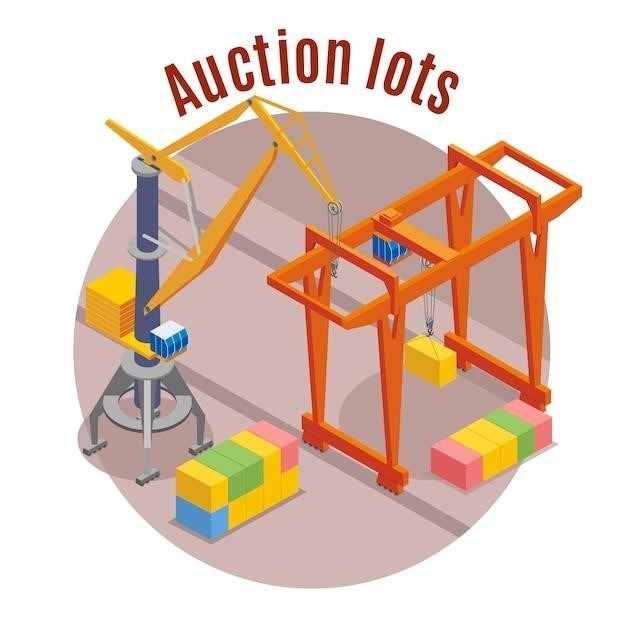JLG Scissor Lift Manual⁚ A Comprehensive Guide
This manual provides a comprehensive guide to operating, maintaining, and troubleshooting JLG scissor lifts. It covers all aspects of the lift, from basic operation to advanced troubleshooting. Whether you’re a seasoned operator or a first-time user, this manual will equip you with the knowledge you need to operate your JLG scissor lift safely and efficiently.
Introduction
JLG scissor lifts are versatile and essential equipment for a wide range of applications, from construction and maintenance to industrial and commercial settings. This manual serves as a comprehensive guide to understanding and operating JLG scissor lifts safely and effectively. It provides detailed information on various aspects of the lift, including its features, controls, operation procedures, maintenance requirements, and troubleshooting tips. The purpose of this manual is to empower users with the knowledge and skills necessary to maximize productivity while ensuring the safety of both the operator and those working in the vicinity of the lift.
Safety Precautions
Operating a JLG scissor lift requires adherence to strict safety precautions to prevent accidents and injuries. Before operating the lift, ensure that you have received proper training and understand the safety procedures outlined in this manual. Always inspect the lift for any damage or defects before use. Never exceed the lift’s rated capacity, and ensure the platform is properly secured before raising or lowering it. Pay close attention to your surroundings, and avoid operating the lift in hazardous conditions. Use appropriate personal protective equipment, such as hard hats, safety glasses, and gloves. Never attempt to modify or alter the lift without proper authorization.
Operating Procedures
This section details the procedures for safely and effectively operating a JLG scissor lift. Before starting the lift, familiarize yourself with the controls and safety features. Always ensure the lift is parked on a level surface and the outriggers are properly deployed before operation. Operate the lift smoothly and avoid sudden movements or jerking. Be aware of your surroundings and potential hazards, and never operate the lift in high winds or inclement weather. Keep a safe distance from power lines and other obstacles. Always follow the specific instructions provided in the operator’s manual for your particular model of JLG scissor lift.
Starting and Stopping the Lift
To start the JLG scissor lift, ensure the battery is charged and the key switch is in the “ON” position. Engage the emergency brake and ensure the outriggers are properly deployed. Press the start button to initiate the lift. To stop the lift, release the control levers and engage the emergency brake. Always ensure the platform is securely lowered to ground level before exiting. In case of an emergency, use the emergency stop button to immediately halt the lift’s operation.
Driving and Steering
Driving and steering the JLG scissor lift is straightforward. Utilize the control levers located on the platform to maneuver the lift. The left lever controls forward and backward movement, while the right lever controls steering. Maintain a safe speed and avoid sharp turns, especially when operating on uneven terrain. Always be aware of your surroundings and ensure the lift’s path is clear of obstacles. When navigating tight spaces, use the steering controls with caution and ensure the platform does not collide with any structures.
Lifting and Lowering the Platform
To lift the platform, engage the lift control lever. The platform will rise smoothly and steadily. To lower the platform, depress the lowering control lever. The platform will descend at a controlled rate. Never attempt to lift or lower the platform while the lift is in motion. Always ensure the platform is fully lowered before driving the scissor lift. If the platform is not fully lowered, it can cause damage to the lift and/or the surrounding environment.

Platform Controls
The platform controls are located on the control panel on the platform. These controls allow the operator to control the lift’s movement, including lifting and lowering the platform, driving and steering, and operating the emergency stop. The control panel should be kept clean and free of debris. If any controls are malfunctioning, the lift should be taken out of service until repairs are made. Familiarize yourself with the location and function of all platform controls before operating the lift. Always operate the lift in a safe and responsible manner.
Maintenance
Regular maintenance is essential for ensuring the safe and reliable operation of your JLG scissor lift. This includes daily inspections, regular maintenance, and troubleshooting. By performing these maintenance tasks, you can help to prevent costly repairs and ensure the longevity of your lift. This manual provides detailed instructions on how to perform all maintenance tasks. Always follow the manufacturer’s recommendations and use only genuine JLG parts.
Daily Inspections
Before operating your JLG scissor lift, it is essential to perform a thorough daily inspection. This includes checking the tires, brakes, hydraulic system, controls, and safety devices. Look for any signs of damage, leaks, or wear and tear. If you find any problems, do not operate the lift until they are repaired. Regular daily inspections help ensure the safe and reliable operation of your scissor lift.
Regular Maintenance
Regular maintenance is crucial for keeping your JLG scissor lift in optimal working condition. This involves scheduled servicing, such as fluid changes, filter replacements, and inspections of critical components like the hydraulic system, scissor arms, and platform controls. Following the manufacturer’s recommended maintenance schedule ensures the lift’s longevity, safety, and reliable performance. Refer to your JLG scissor lift manual for specific maintenance intervals and procedures.
Troubleshooting
Troubleshooting is an essential skill for any JLG scissor lift operator. This involves identifying and resolving problems that may arise during operation. Common issues include hydraulic leaks, electrical malfunctions, and platform control problems. Refer to your JLG scissor lift manual for a comprehensive troubleshooting guide, including possible causes, solutions, and safety precautions. It’s crucial to follow the manufacturer’s guidelines and consult with a qualified technician for complex issues.
Troubleshooting
Troubleshooting is an essential part of maintaining the functionality of your JLG scissor lift. This section provides guidance on identifying and resolving common problems that may arise during operation. From hydraulic leaks and electrical malfunctions to platform control issues, this guide offers insights into potential causes, solutions, and safety considerations. It’s important to consult your JLG scissor lift manual for a comprehensive troubleshooting guide and to contact a qualified technician for complex issues.
Common Problems and Solutions
This section addresses common problems encountered with JLG scissor lifts and provides practical solutions to restore functionality. Issues like slow lifting, platform drift, and control panel malfunctions are discussed, along with their possible causes. For example, slow lifting could be due to low hydraulic fluid levels, a clogged filter, or a malfunctioning pump. Platform drift may indicate worn or damaged outrigger pads, while control panel problems could stem from loose connections or faulty switches. The guide outlines steps for diagnosing and resolving these issues, emphasizing safety precautions throughout the process.
Advanced Troubleshooting
This section delves into more complex troubleshooting scenarios that may require specialized knowledge and tools. It covers issues like hydraulic system leaks, electrical system faults, and engine problems. The manual provides detailed instructions on how to identify the root cause of these issues, including using diagnostic tools and testing procedures. It also outlines the necessary safety precautions to take when working with potentially hazardous components, such as hydraulic lines and electrical circuits. While this section is intended for experienced technicians, it can also serve as a valuable resource for operators who want to gain a deeper understanding of their JLG scissor lift’s inner workings.
Specifications
This section provides detailed specifications for the JLG scissor lift model in question. It includes vital information like the lift’s maximum capacity, platform dimensions, working height, and power source. This information is crucial for ensuring that the lift is suitable for the intended application and for complying with safety regulations. The manual may also include specifications for optional accessories, such as platform extensions or auxiliary power outlets. Understanding the lift’s specifications is essential for safe and efficient operation.
Lift Capacity
The lift capacity, often expressed in pounds or kilograms, is a crucial specification. It represents the maximum weight the lift can safely handle on its platform; This includes the weight of the operator, any tools or materials, and the platform itself. Exceeding the lift capacity can lead to instability, damage to the lift, and potential injury. The manual will clearly state the lift capacity, and it’s essential to adhere to this limit for safe operation.
Platform Dimensions
The platform dimensions are crucial for determining the workspace and the amount of equipment or personnel that can be accommodated. The manual will specify the platform’s length, width, and height. This information is essential for planning tasks and ensuring that the platform is large enough for the intended use. Knowing the platform dimensions helps to prevent overcrowding and ensures the safe and efficient operation of the lift.
Working Height
The working height is a critical specification for any scissor lift, as it determines the maximum vertical reach of the platform. The manual will clearly state the working height, which is measured from the ground to the highest point of the platform when fully extended. Knowing the working height is essential for planning tasks and ensuring that the lift is capable of reaching the required height for the job. It also helps to ensure the safety of the operator and anyone working on the platform.
Power Source
The power source is a crucial aspect of any scissor lift, as it determines how the lift is powered and how it operates. The manual will specify the type of power source used, which could be electric, diesel, or a combination of both. Electric lifts are typically powered by batteries and are often preferred for indoor use due to their quiet operation and lack of emissions. Diesel lifts, on the other hand, are typically used for outdoor applications where a more powerful and durable power source is required. Understanding the power source of your JLG scissor lift is essential for selecting the appropriate lift for your specific needs and ensuring that it is operated in a safe and efficient manner.
Parts and Accessories
The JLG scissor lift manual will provide a detailed overview of the various parts and accessories available for your specific model. This includes information about the standard components of the lift, such as the scissor arms, platform, and control systems. It will also outline the optional accessories that can be added to enhance functionality and safety, such as outriggers, platform extensions, and safety gates. This section is essential for understanding the capabilities of your lift and for identifying the parts and accessories that are best suited for your specific needs. It can also help you determine the availability of replacement parts and how to obtain them.
Optional Accessories
The JLG scissor lift manual will outline a range of optional accessories that can enhance the functionality and safety of your lift. These accessories are designed to cater to specific job requirements and can significantly improve the overall performance of the lift. Common optional accessories include platform extensions to increase working area, outriggers for added stability, and safety gates to prevent accidental falls. The manual will provide detailed descriptions of each accessory, including its features, benefits, and installation instructions. It will also offer guidance on choosing the right accessories to meet your specific needs and enhance the overall efficiency and safety of your work.
Replacement Parts
The JLG scissor lift manual provides comprehensive information on replacement parts, ensuring that you have the necessary resources to maintain your lift in optimal condition. It will list common wear and tear parts, including hydraulic hoses, seals, and platform components, along with their specifications and ordering information. The manual will also offer guidance on identifying and ordering the correct replacement parts for your specific model, ensuring compatibility and safety. This section serves as a valuable resource for maintaining the long-term performance and safety of your JLG scissor lift.
Resources
The JLG scissor lift manual provides valuable resources to support your ownership and operation of the lift. It outlines the JLG website as a comprehensive source of information, offering access to downloadable manuals, product specifications, and safety guidelines. The manual also includes a JLG dealer locator, allowing you to easily find authorized dealers in your area for service, parts, and support. Additionally, the manual provides contact information for JLG customer support, ensuring you have access to expert assistance whenever you need it. These resources ensure that you have the support you need to operate your JLG scissor lift safely and effectively.
JLG Website
The JLG website serves as a central hub for all things JLG, offering a wealth of information for scissor lift users. The website provides access to a library of downloadable manuals, including operator’s manuals, parts manuals, and safety guides. These manuals offer detailed instructions on operation, maintenance, and troubleshooting. Additionally, the website features a comprehensive product catalog, allowing users to explore specifications, features, and accessories for various JLG scissor lift models. The JLG website is your go-to resource for all your scissor lift needs.
JLG Dealer Locator
The JLG Dealer Locator is an invaluable tool for finding authorized JLG dealers in your area. This online resource allows you to easily search for dealers based on your location or zip code. The Dealer Locator provides contact information for each dealer, including their address, phone number, and website. This tool is essential for accessing local support, obtaining replacement parts, and scheduling routine maintenance for your JLG scissor lift. The JLG Dealer Locator ensures you have quick and convenient access to the expertise and resources you need to keep your scissor lift running smoothly.
JLG Customer Support
JLG offers comprehensive customer support to ensure you have the assistance you need to operate and maintain your scissor lift effectively. Their dedicated customer support team is available to answer your questions, address concerns, and provide technical guidance. Whether you require troubleshooting assistance, need to order replacement parts, or have general inquiries about your scissor lift, JLG’s customer support team is readily available to provide prompt and helpful service. This commitment to customer satisfaction ensures you have access to the resources you need to maximize the performance and longevity of your JLG scissor lift.




